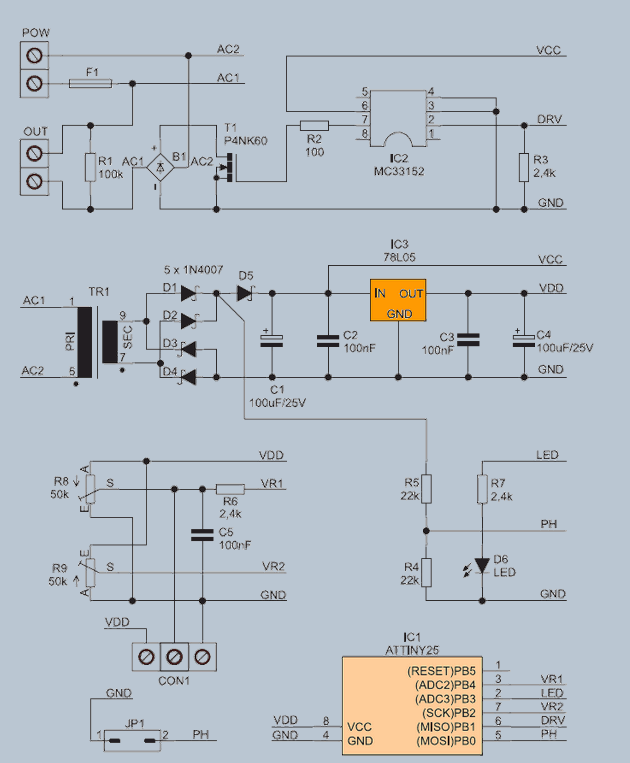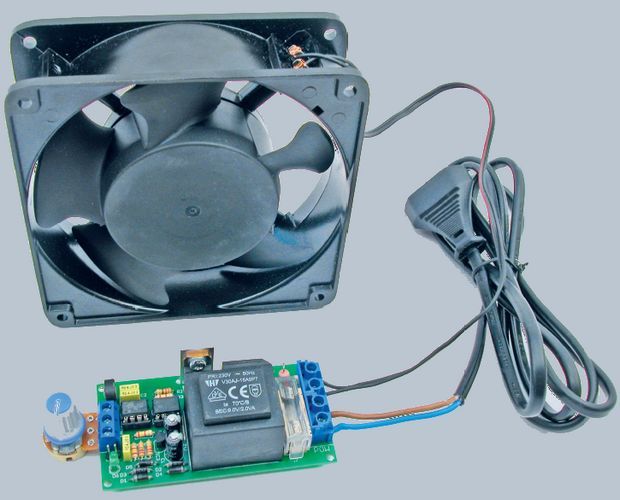
Brushless asynchronous motors, with compact rotor windings, called short cages, are used to drive different fans. Their advantages are durability and simple construction. The presented layout uses a certain characteristic of such a fan to regulate its rotational speed.
The operation is based on a group control method – the motor is powered by a sinusoidal 230V AC for several full periods, and then the power is cut off for several more periods.
Turn on and off times range from a fraction of a second to a few seconds, and thanks to the inertia of the fan, there is no stopping and starting effect of the engine, only the effect of light “swing” rotation.
Switching time is constant while changing the pause time between successive starts is controlled by the output power supplied to the receiver and, consequently, the engine speed.
230V Fan Regulator Schematic

The ATtiny25 fan regulator’s schematic diagram is shown in Figure 2. The triacs “do not like” the inductive loads, so the rarely used circuit with the rectifier bridge and the P4NK60 MOSFET transistor are used instead of the triac actuator. This solution is more reliable in this application. The MC33152 special driver is correct for switching the transistor
The transformer, the LED and the IC3 stabilizer provide +5 V to power the ATtiny25 microcontroller. The diode signals the operation of the system – the flashing frequency is proportional to the set power, and the diode D5 and the resistors R5 and R4 form a zero-voltage detection system.

FILE DOWNLOAD LINK LIST (in TXT format): LINKS-25790.zip
Published: 2017/10/01 Tags: avr project, microcontroller projects, power electronic projects
230V Lüfter Regler Schaltung Mosfet MC33152 ATtiny25
Bürstenlose Asynchronmotoren mit kompakten Rotorwicklungen, sogenannten Kurzkäfigen, werden zum Antrieb verschiedener Ventilatoren verwendet. Ihre Vorteile sind Haltbarkeit und einfache Konstruktion. Das dargestellte Layout verwendet eine bestimmte Charakteristik eines solchen Lüfters, um seine Rotationsgeschwindigkeit zu regulieren.
Der Betrieb basiert auf einer Gruppensteuerungsmethode – der Motor wird für mehrere volle Perioden von einer sinusförmigen 230 V AC gespeist, und dann wird die Stromversorgung für mehrere weitere Perioden unterbrochen.
Ein- und Ausschaltzeiten liegen im Bereich von Sekundenbruchteilen bis zu einigen Sekunden, und dank der Trägheit des Lüfters gibt es keinen Stopp- und Start-Effekt des Motors, nur die Wirkung der leichten “Schwung” -Drehung.
Die Schaltzeit ist konstant, während die Pausenzeit zwischen aufeinanderfolgenden Starts durch die dem Empfänger zugeführte Ausgangsleistung und folglich die Motordrehzahl gesteuert wird.
230V Lüfterregler Schema